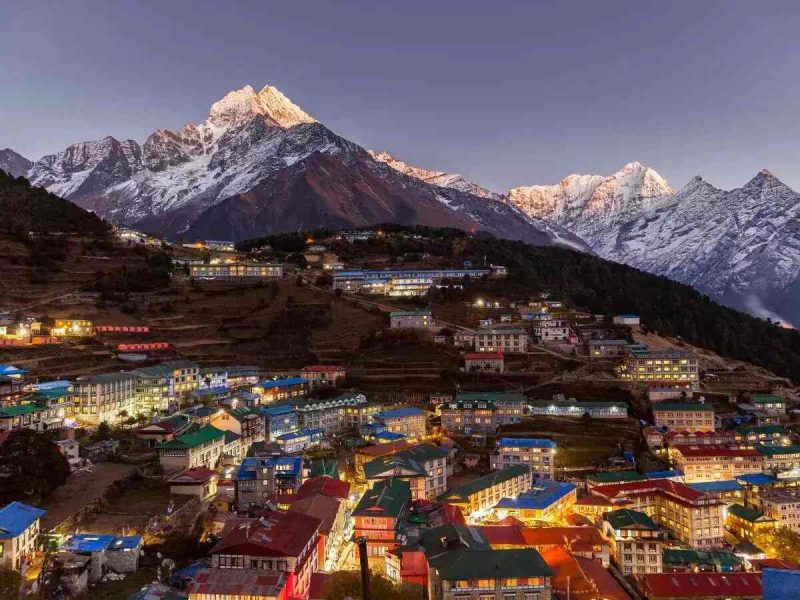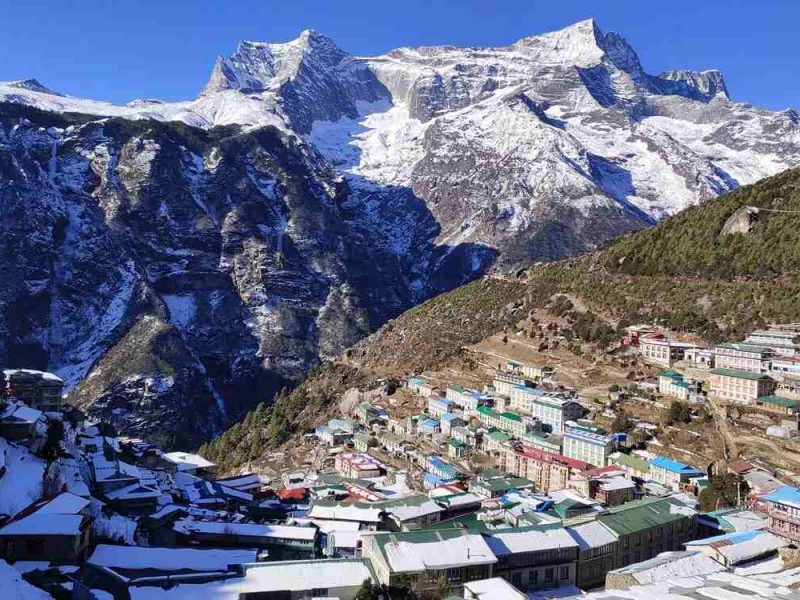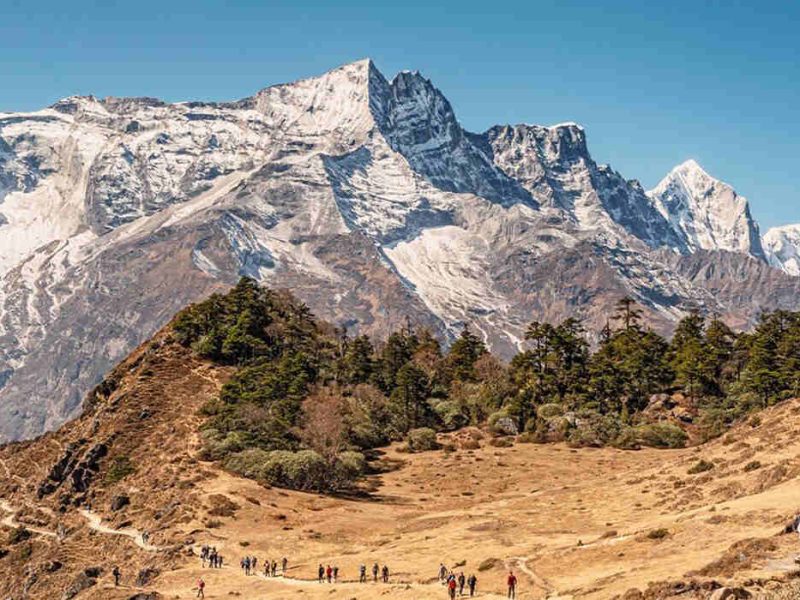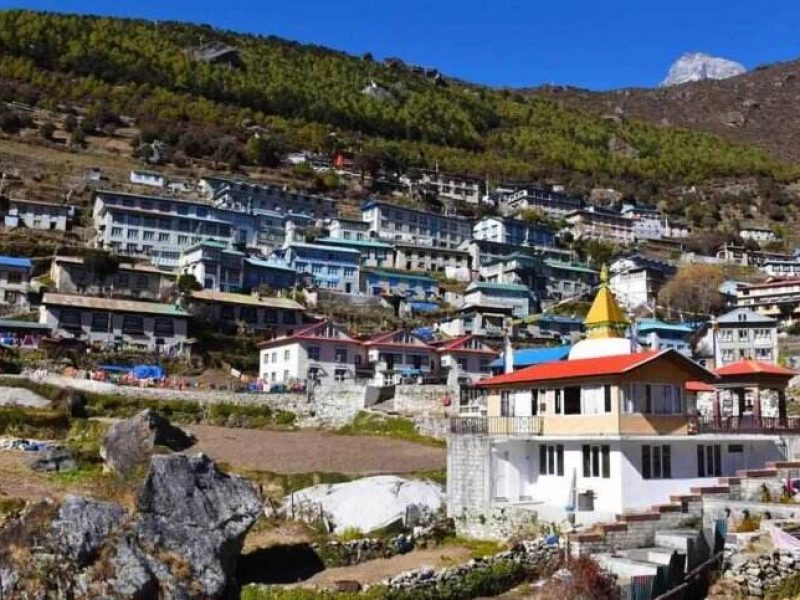Namche Bazaar is a town in the Khumbu region which is a vital hub for trekkers and mountaineers venturing into the Everest region. It is situated at an altitude of approximately 3,440 meters and serves as a logistical center for trekkers, providing supplies, equipment, and medical assistance.
Its beauty lies in its breathtaking surroundings, including towering peaks and lush green valleys with rhododendron forests. The town is also rich in cultural richness, reflecting the traditions and customs of the Sherpa people.
The town’s vibrant market streets, teahouses, and lodges provide comfortable accommodation and hearty meals for weary trekkers. It is a destination in its own right, offering a unique blend of adventure, culture, and natural beauty.
Visitors can explore ancient monasteries, participate in traditional ceremonies and festivals, and interact with friendly locals. It is a vibrant community, offering a sense of closeness and adventure.
History Of Namche Bazaar
Namche Bazaar has a rich history dating back to its emergence as a trading hub along ancient trans-Himalayan routes. The town’s strategic location along trade routes between Tibet, Nepal, and India played a crucial role in its development as a bustling market town.

Its weekly market is known as “haat bazaar,” and became a focal point for trade and commerce. The town also holds significant cultural and religious significance for the Sherpa people, with several monasteries, including the Tengboche Monastery, serving as a center of Buddhist worship and spiritual learning.
Modern development in Namche Bazaar is attributed to the arrival of tourists and mountaineers seeking to conquer Mount Everest and other peaks. The town’s infrastructure expanded to cater to trekkers’ needs, contributing to its legacy as a beacon of exploration and discovery in the heart of the Himalayas.
When To Visit Namche Bazaar?
Namche Bazaar is a popular destination in Nepal, offering a variety of seasons to suit different preferences and interests. Spring (March to May) offers vibrant colors, moderate weather, and cultural festivals.
Trekking is most popular during certain times of the year. During summer (June to August), there are fewer trekkers and lower costs, but heavy rain can make trails slippery and lead to landslides.
Autumn (September to November) is the best time to visit Namche Bazaar and the Everest region, with clear skies and great views, but it’s crowded and more expensive. Winter (December to February) offers peaceful surroundings and clear views, but it can be cold and facilities are limited.
To prepare for your trip, check the weather forecast, get permits, and pack accordingly for a memorable adventure in the Himalayas.
What Is Namche Bazaar Famous For?
As Namche Bazaar is located in the Himalayas, it is a popular destination for trekkers and travelers due to its role as the gateway to Mount Everest, rich Sherpa culture, vibrant market, and excess of adventure activities.
The town is surrounded by towering peaks like Everest, Lhotse, and Ama Dablam, offering panoramic views and a picturesque setting. Visitors can involve themselves in the Sherpa culture by exploring ancient monasteries, participating in traditional ceremonies, and interacting with locals.
The weekly market is known as “haat bazaar,” that attracts traders and villagers to buy, sell, and barter goods. It also offers guided tours, cultural excursions, and village visits, providing insights into the unique way of life in the Khumbu region.
Location Of Namche Bazaar
Namche Bazaar, a UNESCO World Heritage Site of the Himalayas, is a town nestled in a natural arena shaped by the Dudh Koshi River. It sits at an elevation of around 3,440 meters, making it a crucial adjustment point for trekkers heading towards higher altitudes.

The town is accessible primarily by foot or helicopter, with the Everest Base Camp trekking route starting from Lukla. Nearby landmarks include the significant Tengboche Monastery, visited by many trekkers, and Everest Base Camp.
Gateway To Everest
Namche Bazaar is the main trading hub and administrative center of the Khumbu region. It is a crucial accommodation point for trekkers allowing them to adjust to the high altitude before continuing their journey..
It acts as a logistical center providing various shops, bakeries, restaurants, and gear stores for replenishing supplies and accessing essential services. Additionally, it serves as a cultural hub where visitors can immerse themselves in Sherpa culture through ancient monasteries and traditional ceremonies.

From Namche Bazaar, trekkers can begin on various trekking routes leading deeper into the Everest region, enjoying stunning vistas, unique landscapes, and culture. As the “Gateway to Everest” Namche Bazaar is the perfect launching site for an unforgettable Himalayan adventure.
Breathtaking Scenery From Namche Bazaar
Namche Bazaar is renowned for its breathtaking scenery which is surrounded by towering peaks and lush green valleys. Firstly, the town’s most prominent peaks are Mount Everest, Lhotse and Ama Dablam which dominate the skyline and provide stunning views.
From various points, visitors can enjoy panoramic views of the surrounding Himalayan landscape, including lush valleys, cascading waterfalls, and meandering rivers. As trekkers ascend, the vistas become even more expansive, with snow-capped peaks stretching as far as the eye can see.
The town also boasts pristine valleys adorned with dense forests, vibrant meadows, and alpine flora. The Dudh Koshi River, which flows through the valley, adds to the scenic beauty, with its turquoise waters contrasting with the rugged terrain.
The ever-changing landscapes, from lush forests and meadows to rocky moraines and glacial valleys, captivate the imagination with their changing light and weather conditions. It offers an unforgettable experience amidst some of the most stunning scenery on Earth.
Rich Cultural Heritage Of Namche Bazaar
Namche Bazaar is a living proof of the rich cultural heritage of the Sherpa people. The town earns renown for its resilience, hospitality, and mountaineering prowess, showcasing a strong community, reverence for nature, and commitment to Buddhist principles.

The Sherpa people, originally from Tibet, migrated to Nepal and settled in the Khumbu region. They established communities like Namche Bazaar. They strongly emphasize community, revere nature, and remain loyal to Buddhist principles in their culture.
It is home to several monasteries and gompas, each with colorful prayer flags, detailed murals, and ornate statues of Buddhist deities. In addition, visitors can explore these sites, participate in prayer ceremonies, and learn about the spiritual heritage of the Sherpa people. The town also features traditional practices and customs, such as Sherpa cuisine and architecture.
Trekker’s Haven Namche Bazaar
Namche Bazaar is a bustling town that offers a variety of amenities and services for trekkers. It provides a comfortable and welcoming place to rest and recharge after a long day on the trail. The town offers a variety of accommodation options, from traditional Sherpa-style accommodations to modern lodges and hotels.
Trekkers can choose from traditional Sherpa-style accommodations or modern amenities like hot showers, Wi-Fi, and comfortable beds. It also serves as a shopping hub for trekkers, offering a variety of food options, from local eateries to international restaurants.
It also houses a variety of shops selling essential items like water, snacks, sunscreen, and first aid supplies. As a vital acclimatization point along the Everest Base Camp trek, it allows trekkers to adjust to the high altitude before continuing their ascent.
Moreover, the town also offers cultural immersion opportunities, such as visiting monasteries, museums, and cultural centers, where visitors can learn about Sherpa history, religion, and way of life. Namche Bazaar is a must-visit destination for trekkers, offering a warm hospitality, stunning scenery, and rich cultural heritage.
Adventure Awaits In Namche Bazaar
Namche Bazaar is a hub of adventure activities in the Himalayan region, offering a variety of thrilling experiences for thrill-seekers. Trekking is the primary activity, with numerous routes leading to iconic destinations in the Everest region.
Alternative routes like the Gokyo Lakes, Three Passes, or Everest High Passes trek provide more challenging experiences. Mountain biking enthusiasts can explore the rugged terrain and stunning scenery of the Himalayas with guided tours. Paragliding offers a bird’s-eye view of the majestic Himalayan landscape with tandem flights.
Helicopter tours provide a unique perspective of the Himalayas, allowing passengers to soar over towering peaks, remote villages, and ancient monasteries. High-altitude trekking routes, such as the Everest Three Passes and Island Peak summit, offer challenging yet rewarding experiences.
Furthermore, cultural exploration in Namche Bazaar includes visiting ancient monasteries, attending traditional Sherpa ceremonies, and interacting with local villagers. Overall, it provides endless opportunities for adventure seekers in the heart of the Everest region.
Conclusion
In conclusion, Namche Bazaar is a trekkers’ paradise in the Himalayas that offers a blend of natural beauty, cultural richness, and adventure opportunities. It serves as a gateway to Mount Everest offering a once-in-a-lifetime opportunity to explore the breathtaking landscapes and immerse oneself in the rich Sherpa culture. The town’s warm hospitality, diverse accommodation options, and vibrant market add to its allure.
It also serves as a hub of adventure activities, offering trekking, mountain biking, paragliding, and helicopter tours. Lastly, Trek Me Nepal is a leading trekking agency in Nepal which ensures a safe, enjoyable, and unforgettable adventure in the Everest region.
Frequently Asked Questions (FAQs)
1.What is Namche Bazaar?
Namche Bazaar is a vibrant Sherpa town located in the Khumbu region of eastern Nepal. It serves as a gateway to Mount Everest and is a popular stopover for trekkers and adventurers.
2.Why is Namche Bazaar considered a trekkers’ paradise?
3.What are the main attractions in Namche Bazaar for trekkers?
The main attractions in this Bazaar include its strategic location along the Everest Base Camp trekking route, stunning views of Everest and neighboring peaks, rich Sherpa culture, and abundance of adventure activities such as trekking, mountain biking, and paragliding.
4.How do I get to Namche Bazaar?
Namche Bazaar is accessible primarily by trekking from Lukla, a small town with an airport that serves as the main entry point to the Khumbu region. Trekkers typically fly from Kathmandu to Lukla and then trek for several days to reach this Bazaar.
5.What is the best time to visit Namche Bazaar?
The best time to visit Namche Bazaar is during the spring and autumn seasons when the weather is mild, and the skies are clear, offering stunning views of the Himalayas. These seasons also coincide with the peak trekking seasons in the region.
6.What accommodation options are available in Namche Bazaar?
It offers a range of accommodation options, including teahouses, guesthouses, lodges, and hotels, catering to various budgets and preferences. Trekkers can choose between traditional Sherpa-style accommodations or more modern amenities with hot showers and Wi-Fi.
7.Are there any cultural activities to experience in Namche Bazaar?
Visitors can engage in cultural activities in Namche Bazaar, such as visiting ancient monasteries, taking part in traditional Sherpa ceremonies and festivals, and interacting with local villagers to learn about Sherpa culture, history, and traditions.
8.What adventure activities can I enjoy in Namche Bazaar?
This Bazaar offers adventure activities like trekking to Everest Base Camp, biking on rugged trails, paragliding for aerial views, and helicopter tours for unique perspectives of the region.

Comment (0)